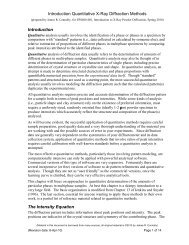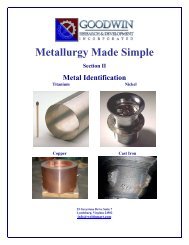Metallography and Microstructures of Cast Iron
Metallography and Microstructures of Cast Iron
Metallography and Microstructures of Cast Iron
Create successful ePaper yourself
Turn your PDF publications into a flip-book with our unique Google optimized e-Paper software.
<strong>Metallography</strong> <strong>and</strong> <strong>Microstructures</strong> <strong>of</strong> <strong>Cast</strong> <strong>Iron</strong> / 585nary euetectic is called a pseudobinary eutectic,because carbon is removed from the eutectic duringdiffusion in the solid state (Ref 13).Fig. 89 Austempered ductile iron (the same compositionas in Fig. 32). Acicular ferrite <strong>and</strong> austenite.The casting was austempered: 900 C (1650 F), held 2h, taken to salt bath at 380 C (715 F), held 180 min, <strong>and</strong>air cooled. Etched with 4% nital. 500Ductile iron microstructures normally consist<strong>of</strong> pearlite or pearlite <strong>and</strong> ferrite with graphitenodules surrounded with ferrite, which looklike a white halo, although the more commonname <strong>of</strong> this structure is the bull’s-eye structure.Figures 82 <strong>and</strong> 83 show this type <strong>of</strong> microstructure,while Fig. 84 shows a fully ferritic-matrixmicrostructure that was achieved after annealinga chilled casting with a microstructure containingcementite, ferrite, <strong>and</strong> pearlite (see alsoFig.11). In some cases, usually at a high coolingrate, cementite occurs as a separate constituentin the matrix.The precipitates <strong>of</strong> cementite are situated inthe exterior regions <strong>of</strong> the eutectic cells or in theinterdendritic spaces <strong>of</strong> the transformed austenitedue to the microsegregation <strong>of</strong> carbide-formingelements, such as manganese, chromium, orvanadium. Cementite appears very frequently inchill castings or in thin-walled s<strong>and</strong> castings (Ref13). Figures 85 <strong>and</strong> 86 show the microstructure<strong>of</strong> pearlitic ductile iron with cementite <strong>and</strong> ledeburite.In this case, cementite was a desired constituent<strong>of</strong> the microstructure to improve thewear resistance <strong>of</strong> cast iron. It was achieved byfeeding the melted metal with an iron-magnesiumfoundry alloy, without inoculation. Thegraphite nodules do not have a perfect shape.Figure 87 shows the microstructure <strong>of</strong> a heat<strong>and</strong>wear-resistant ductile iron containing chromium<strong>and</strong> nickel, which consists <strong>of</strong> chromiumcarbides in an austenitic matrix.The austempering heat treatment is used toachieve better mechanical properties in ductileiron. The casting is heated to a temperature range<strong>of</strong> 840 to 950 C (1545 to 1740 F) <strong>and</strong> held atthis temperature until the entire matrix is transformedto austenite saturated with carbon. Thecasting is then quenched rapidly to austemperingtemperature, between 230 <strong>and</strong> 400 C (445 <strong>and</strong>750 F), <strong>and</strong> held at this temperature for the requiredtime (Ref 14). When this cycle is properlyperformed, the final structure <strong>of</strong> the matrix,which is called ausferrite, consists <strong>of</strong> acicularferrite <strong>and</strong> austenite, <strong>and</strong> the iron is called austemperedductile iron (ADI). The morphology<strong>and</strong> amount <strong>of</strong> ferrite depends on the time <strong>and</strong>temperature <strong>of</strong> the austempering process. Figures88 <strong>and</strong> 89 show an ADI microstructure afteraustempering heat treatment, when the casting inboth cases was held in the furnace for 180 min,<strong>and</strong> the annealing temperatures were different.The use <strong>of</strong> a higher temperature changed themorphology <strong>of</strong> the ferrite <strong>and</strong> increased theamount <strong>of</strong> austenite. Figure 90 shows the ADImicrostructure after 2 min austempering heattreatment, when the transformation <strong>of</strong> austeniteto acicular ferrite was just started, so martensiteis the dominant phase, <strong>and</strong> there is only a smallamount <strong>of</strong> acicular ferrite, mostly surroundingthe graphite nodules (see also Fig. 31 to 37).Compacted graphite-iron matrix microstructuresconsist <strong>of</strong> ferrite <strong>and</strong> pearlite; theamount <strong>of</strong> each constituent depends on the coolingrate <strong>and</strong> the chemical composition (elementsthat promote either ferrite or pearlite solidifica-Fig. 90 Austempered ductile iron (the same compositionas in Fig. 32). Martensite <strong>and</strong> small amount<strong>of</strong> acicular ferrite (AF). The casting was austempered: 900C (1650 F), held 2 h, taken to salt bath at 300 C (570 F),held 2 min, <strong>and</strong> air cooled. Etched with 4% nital. 1000Fig. 91 As-cast iron with compacted graphite (Fe-2.8%C-1.9%Si-0.55%Mn-0.04%P-0.2%S-0.018%Mg). Ferritic-pearlitic matrix. Etched with 4% nital.100Fig. 92 Malleable iron (Fe-2.95%C-1.2%Si-0.53%Mn-0.06%P-0.21%S-0.08%Cr-0.10%Cu-0.07%Ni-0.01%Al). The casting was annealed: at 950 C(1740 F), held 10 h, furnace cooled to 720 C (1330 F),held 16 h, <strong>and</strong> air cooled. Pearlitic-ferritic matrix. Etchedwith 4% nital. 125 (microscopic magnification 100)








